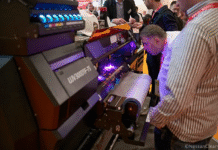Hiral Cards, a printer of wedding and invitation cards located in south Mumbai’s Girgaon, recently bought a new Canon ImagePress C710 color digital production press.
The three-decade-old Hiral Cards began operations with a screen printing unit, which was later sold off. Most of the card printing work was being outsourced to third-party printers. But the volumes fell during the pandemic and, in this scenario, going for a digital printing unit made sense.
At present, the operations are managed by brothers Dixit Sanghavi and Jaydeep Sanghavi. “We print a variety of cards but wedding cards are the main revenue generator. Till demonetization, our business was flourishing. The decline in volumes started post-demonetization, which took a sharp dive after the pandemic. These days, the average demand is for around 25-50 cards. In such a situation, getting an in-house digital printing press made a lot of sense,” says Dixit Sanghavi.

Sanghavi says the multiple Covid lockdowns led to the cancellation of weddings and events, which affected their business. And even if weddings were held, the number of guests was restricted.
“During the lockdown and even later, people started sending e-invites and digital cards. This trend has solidified. Earlier, many would get offended if they did not get a physical card. That mindset has now changed. People are now okay with e-invites and digital cards. And that is why the volume of physical cards has declined sharply. Now people get less than 100 wedding cards printed,” he says.
Digital press makes sense
The ImagePress C710 was installed at Hiral Cards in early September. Sanghavi says it makes sense to have a digital press given that the average demand is for about 50 cards.
“The press is easy to operate and we are able to do other commercial printing jobs such as printing business cards, labels, brochures, flyers, envelopes, and letterheads. We are printing about 6000 sheets of 12X18-inches and 13X19-inches every month. We expect our volumes to pick up,” Sanghavi says.
The ImagePress C710 can print at a speed of 70 pages per minute with a resolution of 2,400 dpi x2,400 dpi. It can handle a variety of paper stocks such as plain, heavy, coated, and specialty, from A4 to 13X51-inch size. In addition to the Efi Fiery G250 kit, the printer comes with the option of an IPR kit for those looking for a more economical option. Hiral Cards has opted for the Fiery kit.
















